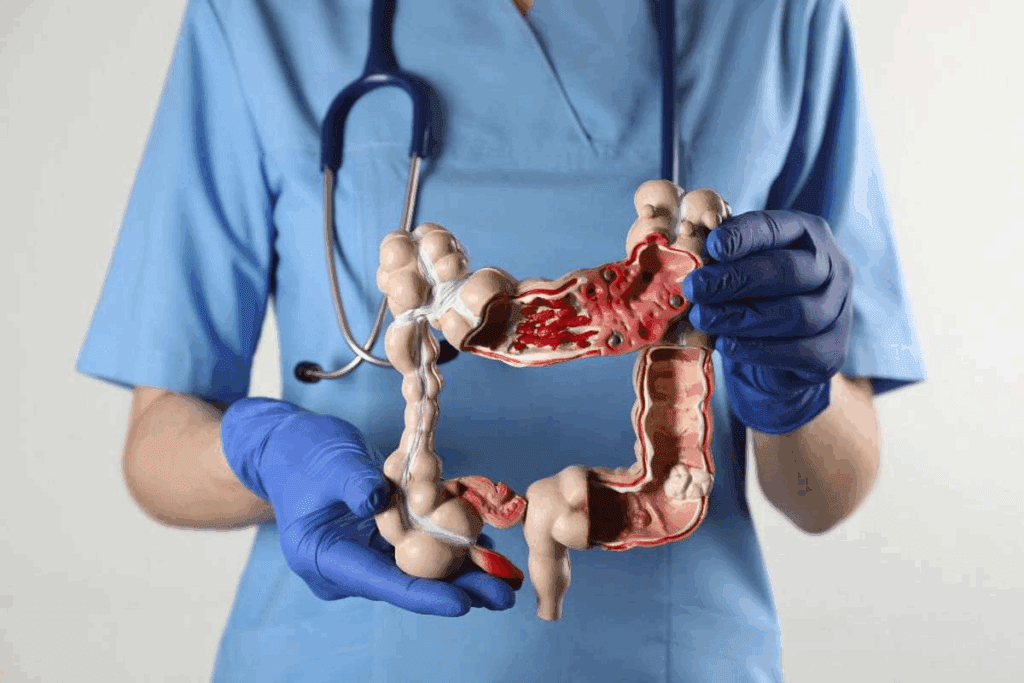Last Updated on November 26, 2025 by Bilal Hasdemir

Knowing the differences between the left colon and right colon is key for treating colorectal cancer right. The colon is split into two parts, each with its own traits and how cancer shows up.
Liv Hospital, a top name in care, explains the seven main differences between the left and right colon. This helps patients understand their diagnosis and treatment better.

Knowing the colon’s anatomy is key to diagnosing and treating many gut problems. The colon, or large intestine, is vital for our digestion.
The colon absorbs water and salts from food, stores waste, and eliminates it. It has different parts, each with its own job.
The colon’s wall has layers like the mucosa and muscularis. The mucosa helps with absorption and secretion. The muscularis layer moves food through the colon.
The colon is split into left and right parts. The right colon includes the cecum, ascending colon, and hepatic flexure. The left colon has the descending colon, sigmoid colon, and rectum.
Knowing the left and right colon is important for medical diagnosis and treatment. Each part of the colon deals with different diseases and has unique functions.

The colon is divided into left and right sections. Each part has its own role in digestion.
The left colon includes the descending, sigmoid, and rectum. The descending colon helps move feces to the sigmoid colon.
The sigmoid colon is shaped like an S. It connects the descending colon to the rectum. It’s key for storing and getting rid of feces.
The rectum is the last part of the left colon. It holds feces until they are passed out of the body.
The right colon has the cecum, ascending, and hepatic flexure. The cecum is a pouch at the large intestine’s start.
The ascending colon goes up from the cecum. It’s important for absorbing water and electrolytes.
The hepatic flexure is near the liver. It marks where the ascending colon meets the transverse colon.
Knowing the areas where the colon parts meet is key. It helps find important landmarks.
| Colon Section | Components | Function |
| Left Colon | Descending, Sigmoid, Rectum | Storage and elimination of feces |
| Right Colon | Cecum, Ascending, Hepatic Flexure | Water and electrolyte absorption |
The left and right colon have different jobs in digestion. The left colon deals with storing and getting rid of feces. The right colon focuses on absorbing water and electrolytes.
Knowing how the colon develops is key to understanding its left and right sides. The colon forms from the midgut and hindgut. These parts develop into the right and left colon, respectively.
The right colon comes from the midgut, while the left colon forms from the hindgut. This difference affects their blood supply and how they drain. The midgut and hindgut grow differently, leading to unique structures and functions in the left and right colon.
Midgut derivatives, like the right colon, get their blood from the superior mesenteric artery (SMA). On the other hand, hindgut derivatives, such as the left colon, are supplied by the inferior mesenteric artery (IMA). This is because of their different origins in the embryo.
The colon’s blood comes mainly from the SMA and IMA. The right colon, being a midgut part, gets its blood from the SMA. This includes the ileocolic, right colic, and middle colic arteries.
The left colon, a hindgut part, gets its blood from the IMA. This includes the left colic and sigmoid arteries.
| Colon Section | Arterial Supply | Origin |
| Right Colon | Superior Mesenteric Artery (SMA) | Midgut |
| Left Colon | Inferior Mesenteric Artery (IMA) | Hindgut |
The colon’s venous drainage mirrors its arterial supply. The right colon’s blood goes to the superior mesenteric vein. This vein then joins the splenic vein to form the portal vein.
The left colon’s blood goes to the inferior mesenteric vein. This vein also joins the splenic vein and then the portal vein.
Lymphatic drainage is similar. Lymph from the right colon goes to nodes along the SMA. Lymph from the left colon goes to nodes along the IMA. Knowing these patterns helps us understand how diseases spread in the colon.
It’s important to know how the left and right colon work differently. The colon is key to our digestive system. Each part has its own job.
The right colon focuses on water absorption and keeping electrolytes balanced. It pulls water and salts from the content, making the stool more concentrated. The left colon, on the other hand, works on stool consistency and holding it until it’s time to go.
The right colon’s bigger size and special mucosa help it absorb water well. This is important for keeping us hydrated and avoiding too much water loss.
The time it takes for content to move through the colon is different for the left and right sides. The right colon takes longer, which helps with water absorption and fermentation. The left colon moves things faster, helping to store and get rid of stool.
The right colon uses retrograde contractions to mix and absorb content. The left colon uses anterograde contractions to push stool towards the rectum.
The bacteria in the left and right colon are different. This is because of differences in luminal pH, substrate availability, and oxygen levels. The right colon has more bacteria, which break down carbs that we can’t digest.
In the right colon, these bacteria make short-chain fatty acids. These are a good energy source for the colon’s cells. The left colon also has bacteria, but they are better at processing residual substrates.
The left and right colon have different structures that affect their work and how they get sick. These differences help us understand their roles in keeping our gut healthy.
The left and right colon look different inside. The right colon has a bigger dilated lumen and thinner mucosa than the left. This is because they do different jobs.
The right colon mainly absorbs water and electrolytes. The left colon stores and moves stool.
The right colon has more lymphoid follicles for immune defense. The left colon has organized lymphoid tissue, forming lymphoid aggregates.
The cells in the left and right colon are different too. The right colon has more absorptive cells and goblet cells for mucus. This helps with water absorption and lubrication.
The left colon has more enteroendocrine cells for hormone production. This meets its unique physiological needs.
The pH and chemical makeup of the left and right colon vary. The right colon is more anaerobic with a higher pH. This is because of a diverse microbial community that breaks down carbs.
The left colon is more acidic due to fermented products and different microbes. This environment affects the risk of colorectal cancer.
It’s key to know how diseases show up in the left versus right colon. This knowledge helps in managing them better. The way diseases appear in these areas affects how we diagnose and treat them.
Diseases in the left and right colon have different symptoms. Left-sided colon cancers often cause constipation, abdominal cramps, and narrowing of the stool. Right-sided colon cancers might show up with anemia, fatigue, and occult bleeding instead.
The size of the colon and the type of stool play a role in these symptoms. The right colon is wider, and its stool is more liquid. This makes symptoms like bowel obstruction less common. The left colon is narrower, with thicker stool, leading to more obstruction symptoms.
Pain from left colon diseases usually feels like lower abdominal pain. It often happens in the left lower quadrant. Sometimes, this pain can spread to the back or groin.
Right colon diseases might cause more diffuse or right lower quadrant pain. This pain can feel like appendicitis. It might also spread to the right upper quadrant or back, depending on the location and nearby structures.
Obstruction is more common in left-sided colon cancers. This is because the left colon’s lumen is narrower and its stool is thicker. Patients might need emergency care for this.
Bleeding is a symptom of both left and right colon cancers. But the type of bleeding can vary. Right-sided cancers often lead to occult or microscopic bleeding, causing anemia. Left-sided cancers might cause visible rectal bleeding or hematochezia.
| Symptom | Left Colon | Right Colon |
| Obstruction | Common, often presenting with constipation and abdominal cramps | Less common due to larger diameter and liquid stool |
| Bleeding | Often visible, presenting as rectal bleeding or hematochezia | Often occult, leading to iron deficiency anemia |
| Pain Location | Lower abdominal pain, typically left lower quadrant | More diffuse or right lower quadrant pain |
Left and right-sided colon cancers have different traits that affect how they are treated. Knowing these differences is key to creating good treatment plans.
The rate of colon cancer changes between the left and right colon. Right-sided colon cancers are more common in older women. On the other hand, left-sided colon cancers are more common in younger men.
A study in the Journal of Clinical Oncology showed that right-sided colon cancer rates have gone up. This increase is seen more in African Americans.
Colon cancers in the left and right colon look different. Right-sided tumors are often bigger and flat. This makes them harder to spot during colonoscopy.
The size and how fast colon cancers grow differ between the left and right colon. Right-sided tumors grow faster. Left-sided tumors often cause blockages because of their shape.
Genetic and molecular differences between left and right-sided colon cancers are important for treatment. Right-sided tumors often have BRAF mutations. Left-sided tumors usually have KRAS mutations.
| Characteristic | Left-Sided Tumors | Right-Sided Tumors |
| Genetic Mutations | KRAS mutations common | BRAF mutations more frequent |
| Growth Pattern | Polypoid | Flat |
Finding colon cancer is hard, with different areas having different success rates. Colonoscopy is the best way to find it, but it works better in some parts of the colon than others.
Colonoscopy works better for cancers on the left side of the colon. These cancers often cause symptoms and are easier to see. But, cancers on the right side are harder to find because they don’t always cause symptoms and are bigger when found.
Right-sided colon cancers are often missed during colonoscopy. This is because they are in a harder-to-see area and liquid stool can hide them. Studies show that finding polyps is harder in the right colon than the left.
Other imaging like CT colonography and MRI are also key in finding colon cancer. They are used when colonoscopy can’t be done or isn’t enough.
Which imaging to use depends on the patient, the tumor’s location, and what resources are available. CT colonography is good for finding big lesions and seeing how far the disease has spread.
Studies show that more colon cancers are happening on the right side. About 40% of colon cancers are on the right, and 60% are on the left.
It’s important to know about these challenges and rates to improve colon cancer care. By using different ways to find cancer and knowing the regional differences, doctors can do better at finding and treating it.
Different parts of the colon need special treatments for cancer. Where the cancer is located is key to picking the best treatment.
Surgeries for colon cancer change based on where the tumor is. Right colon cancers often get a right hemicolectomy. Left colon cancers might need a left hemicolectomy or sigmoidectomy.
Surgical Considerations:
A study in the Journal of Surgical Oncology says, “the surgical approach for colon cancer should be tailored to the specific location and stage of the disease”
“Surgical resection remains the primary treatment for colon cancer, with the extent of resection determined by the tumor location”
Chemotherapy works differently for cancers in different parts of the colon. Research shows right colon cancers might not respond as well as left colon cancers.
| Cancer Location | Chemotherapy Response |
| Right Colon | Variable response to chemotherapy |
| Left Colon | Generally better response to chemotherapy |
Targeted therapy is becoming more common in treating colon cancer. How well it works can depend on the tumor’s molecular makeup. This makeup can change based on where the cancer is in the colon.
Choosing targeted therapy often depends on certain biomarkers. For example, BRAF mutations are more common in right colon cancers. This might help pick the right therapy.
In summary, treating colon cancer depends a lot on where the tumor is. Knowing these differences is key to making good treatment plans.
The outlook for colon cancer changes based on where the tumor is. Tumors on the left side usually have a better chance of survival than those on the right. This is due to several reasons, like how the tumor grows, when it’s found, and how well it responds to treatment.
Studies show that left-sided colon cancers have better survival rates than right-sided ones. A study in the Journal of Clinical Oncology found that left-sided colon cancer patients live longer than those with right-sided cancer.
| Cancer Location | 5-Year Survival Rate |
| Left Colon | 65% |
| Right Colon | 55% |
Left and right colon cancers behave differently when they come back. Left-sided cancers often come back close to where they started. Right-sided cancers are more likely to spread to other parts of the body. Knowing this helps doctors plan better follow-up care and improve patient results.
Many things affect how well colon cancer patients do, like where the tumor is, how advanced it is, and the patient’s age and health. The tumor’s genetic makeup, like microsatellite instability and KRAS mutations, also matters a lot. These factors help decide how well the cancer will respond to treatment and how long the patient will live.
Key factors influencing outcomes include:
Understanding these factors helps doctors make better treatment plans. Knowing the difference between left and right colon cancers is key. It helps doctors decide on treatments and predict how well patients will do.
Recent studies have greatly improved our knowledge of left and right colon cancers. This progress comes from research into biomarker discoveries, immunotherapy response variations, and emerging therapeutic targets.
Research has found biomarkers specific to left and right colon cancers. For example, KRAS mutations are often found in right-sided colon cancers. On the other hand, BRAF mutations are more common in right-sided tumors.
This knowledge is key for treatment plans. Biomarkers can show which treatments will work best. Ongoing research aims to find more biomarkers for better treatment options.
Immunotherapy is a promising treatment for colon cancer. But, its success varies between left and right colon cancers. Right-sided cancers often have more mutations, making them more responsive to immunotherapy.
Studies suggest that right-sided colon cancers may benefit more from checkpoint inhibitors. This shows the importance of considering the cancer’s location when choosing treatments.
As we learn more about left and right colon cancers, new treatments are being developed. Researchers are looking for targets that exploit the unique features of each type of cancer.
For instance, finding specific genetic mutations in left versus right colon cancers could lead to side-specific treatments. This personalized approach could greatly improve treatment outcomes for colon cancer patients.
Distinguishing between left and right colon cancers is key for better diagnosis and treatment. Knowing the differences between these areas helps in creating more effective colon cancer treatment plans.
The left vs right colon differentiation is more than just where the cancer is. It affects how the cancer is found and treated. The left colon, which includes the descending, sigmoid, and rectum, is different from the right colon. The right colon includes the cecum, ascending colon, and hepatic flexure.
Doctors need to understand these differences to improve colon cancer treatment. This knowledge helps in creating better care plans for patients. It ensures that treatments are more targeted and effective.
In summary, knowing the difference between left and right colon cancers is very important. As we learn more about colon cancer, understanding these differences will be even more critical. It will help in providing the best care for patients.
Left and right colon cancers differ in where they are located, how they present, and how they are treated. These differences come from how they develop, their blood supply, and their functions.
Colon cancer can occur on either side, but some studies suggest right-sided cancers are more common in certain groups.
The left colon includes the descending colon, sigmoid colon, and rectum. The right colon has the cecum, ascending colon, and hepatic flexure. Each part has its own shape and role.
Left colon cancers often cause blockages. Right colon cancers may lead to hidden bleeding and anemia because of differences in stool and cancer type.
Yes, treatments like surgery and chemotherapy can differ based on the cancer’s location. This is because of the unique anatomy and characteristics of each side.
The left and right colon develop from different parts of the embryo. This leads to differences in their structure, function, and risk of cancer.
Knowing the differences is key for accurate diagnosis and treatment. It helps doctors tailor care to each patient, improving outcomes.
Yes, left and right colon cancers have unique genetic and molecular features. These can affect how the cancer behaves, responds to treatment, and how it’s likely to progress.
The right colon absorbs water and ferments food. The left colon stores and eliminates stool. This shows their different roles in the body.
The different bacteria in the left and right colon can change the local environment. This can influence cancer development, growth, and how it responds to treatment.
National Cancer Institute. (2024). Colorectal Cancer Treatment (PDQ®)–Health Professional Version. U.S. Department of Health and Human Services, National Institutes of Health. https://www.cancer.gov/types/colorectal/hp/colon-treatment-pdq
Subscribe to our e-newsletter to stay informed about the latest innovations in the world of health and exclusive offers!